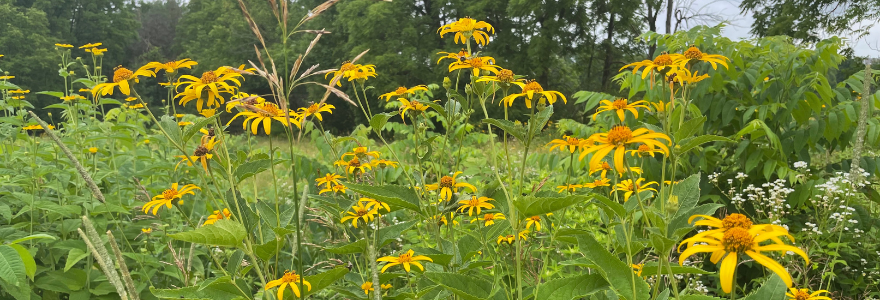Green Space & Gardens

Western University's land is over 450 hectares in total, consisting of diverse landscapes such as old growth Carolinian forest, the Medway Valley Heritage Forest, various gardens, and open spaces. The public is welcome to explore these areas, but is asked to please adhere to posted signage, stay on marked trails, and not disturb ongoing research. Virtual and in-person Green Tours are available to members of the campus community and broader public to learn more about these spaces.
We take pride in our landscape and strive to sustainably maintain our green spaces. This includes the protection of natural areas on campus. For example, common buckthorn (an invasive tree species) has been targeted in forested areas of campus along the river. In our more manicured gardens, plants such as milkweed are left to flower, even in areas where they are not intentionally planted, as they are an important source of food for pollinators.
Our campus is located within the Carolinian Life Zone; the most biodiverse ecological region in Canada. Carolinian trees and shrubs are planted and maintained through the Sherwood Fox Arboretum, alongside other non-Carolinian temperate species. There are ongoing pollinator initiatives with Western's Bee Campus designation, including the growing FOGs Pollinator Garden.
Ecological Landscaping
Landscape Services at Western uses a variety of practices to support ecologically-beneficial plantings across campus. Native plants are considered first in planting plans, and the right plant is selected for the right location. Jane's Garden in the Biological and Geological Sciences Building (BGSB) courtyard is a great example of this planting practice with a variety of both native and non-native plant species.
Rain gardens have been installed near the Physics & Astronomy Building and Music Building, at both the top and bottom of Western's iconic UC Hill to mitigate stormwater runoff into the Deshkan Ziibi (Thames River). These rain gardens consist of a mix of native and non-native species which are drought- and salt-tolerant, and which are pollinator-friendly. During heavy rains or snow melts, the rain gardens absorb excess water and reduce the runoff that would otherwise flow into the river and potentially lead to flooding.
Invasive Species Management
Invasive species are not planted on campus, and those that are in place will stay until they reach their end of life and are cut down (e.g. Norway Maple), along with succession plantings of appropriate species.
Invasive species have been targeted aggressively across campus. Buckthorn and non-native honeysuckle have been targeted in the woods behind IGAB, parts of the river bank, and other areas around campus. An invasive Arailia species was identified by faculty in the Department of Biology, and has also been targeted. The Masters of Environment and Sustainability program participates in an annual "Buckthorn Bust" along the river to control this invasive species in forested areas of campus.
All students, staff and faculty at Western are invited to join Friends of the Gardens volunteer group to get involved with gardens on campus.

